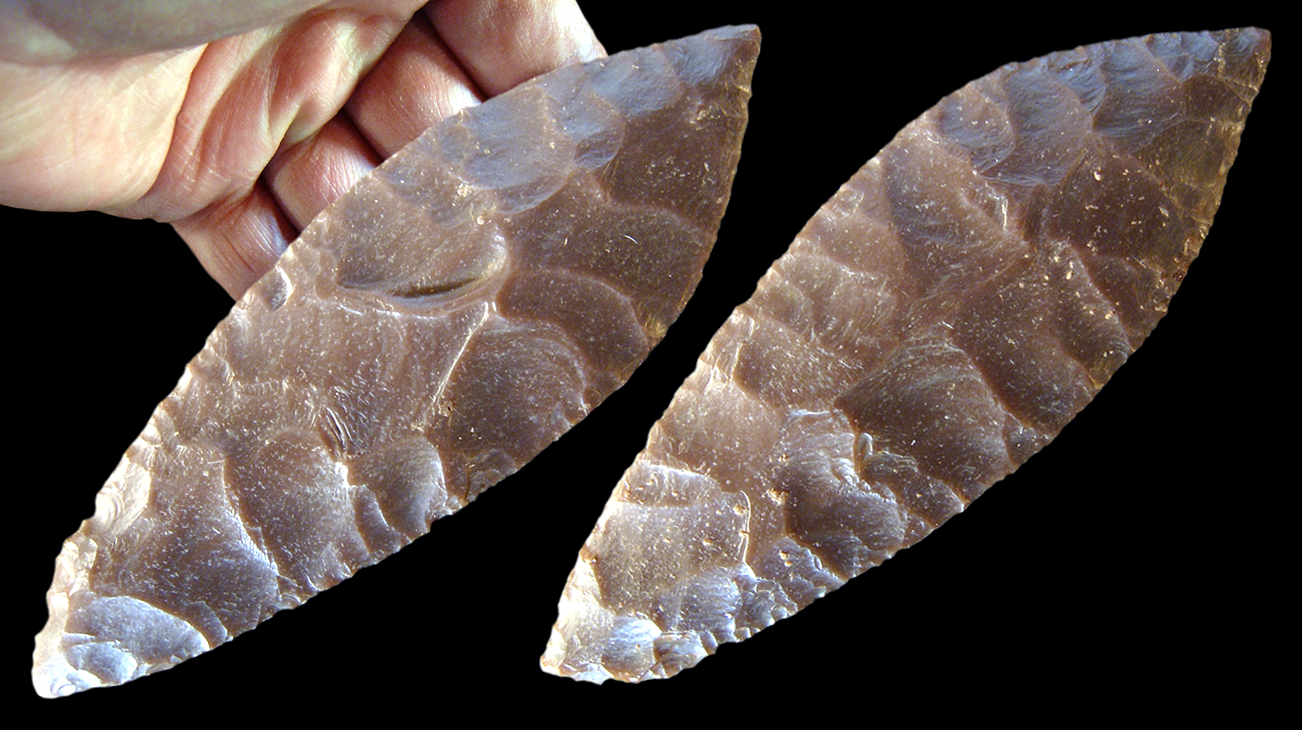|
AZTEC RITUAL KNIFE
CENTRAL VALLEY OF MEXICO
PRE-SPANISH
MEXICO
COPYRIGHT JULY 31,
2012 PETER A. BOSTROM

CAST
ILLUSTRATED
CAST
#PRE-4
AZTEC RITUAL KNIFE
CENTRAL VALLEY OF
MEXICO
PRE-SPANISH
MEXICO
This is a cast of a typical example of an Aztec biface. Aztec bifaces
are reported to have been used in blood sacrifices and buried in ritual
offerings as "personified" forms of different deities. Bifaces like this
have been found in excavations of ceremonial caches in the ancient Aztec
city of Tenochtitlan that is now located under the modern day city of
Mexico City. These unique ritual tools are also referred to as Aztec
knives. This biface measures 6 13/16 inches (17.3 cm) long. It's made of
a semi-translucent brownish/red colored tabular chert that was commonly
used by Aztec flint-smiths.
Recent excavations in the sacred precinct of Tenochtitlan at Templo
Mayor in Mexico City, is providing new information about these types of Aztec ritual
knives. The discovery of a ceremonial deposit contained within a stone box
that is designated as offering 125 is particularly important. The cache
dates to sometime between 1486 and 1502. The stone box is located at the foot of the staircase leading to the Templo Mayor
and it represents an entrance to the underworld. The cache contained
3,800 artifacts including 27 bifaces that were decorated as gods,
priests and warriors. The artifacts were placed in
the box in layers. The lower level contained the body of a dog that was
surrounded by 19 decorated knives and in the upper level two golden
eagles were buried with eight decorated knives. Some of the knives located at
the top of the cache were attached to copal bases and stood upright.
These knives bore eyes and teeth and carried miniature weapons made of
wood, flint and shell. Other knives lower down in the cache
had irregular copal bases or none at all. Copal was an aromatic tree
resin that was burned as incense.
Some of the bifaces in offering 125 were identified as representing
at least three Aztec gods in the form of Ehecatl-Quetzalcoatl, Xochipille
and Techalotl. The most important god is Ehecatl-Quetzalcoatl who descended to the underworld to retrieve the bones
from which humanity was created and introduced maize and auto-sacrifice
(self-sacrifice such as
blood-letting). This
knife was adorned with a "wind jewel" in the form of a truncated shell
worn on the chest, a curved scepter, a marine shell necklace, earrings in the shape of speech marks,
a headdress representing star eyes, the image of a bone needle made of
gold leaf symbolizing auto-sacrifice, monkey fur, and a duck-shaped
pendant.
Xochipille represented the god of music, games flowers and dance.
This knife was identified as Xochipille from a drop-shaped pendant made
of mother-of-pearl. The other god, Techalotl, is associated with the
ritual drink pulque (alcoholic
beverage made from the fermented sap of the maguey plant).
Other knives in the cache were believed to represent gods but there
was not enough evidence to link them to any of the deities. But there
were other knives in the stone box that were "dressed" with weapons that
identified them to warriors. These objects were represented as a wooden
pectoral in the form of a bow, a dart thrower (atlatl)
and projectile points.
A third group of knives were identified as a priestly category.
Three of the knives were "personified" with gourd containers that were
items used by priests to hold tobacco used in ceremonies. Some of the
knives are reported to have been devoid of any decoration. |
